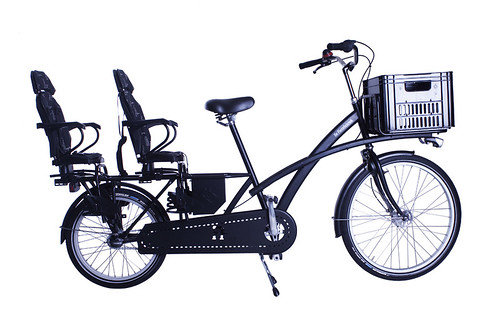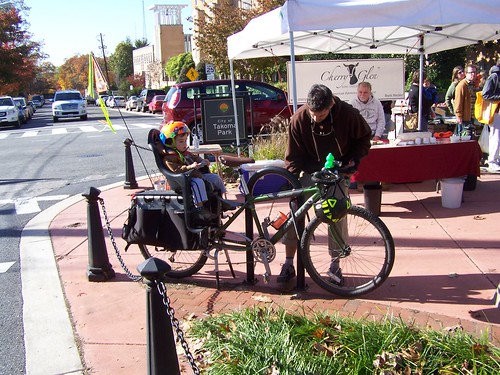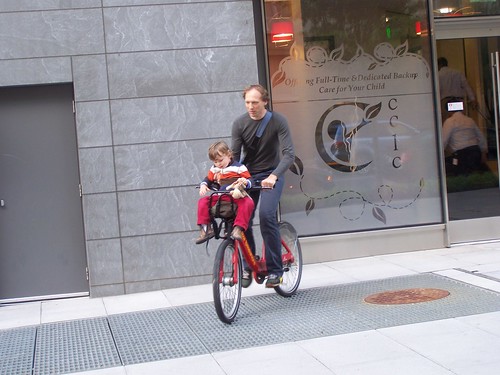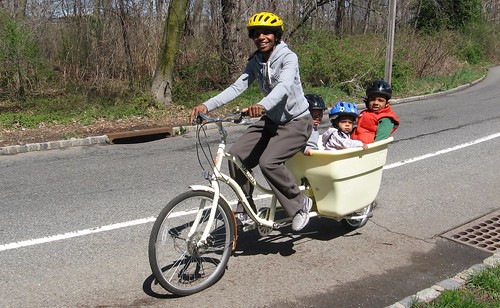Dutch bike for adult carrying two children
Among the various types of bikes sold by the De Fietsfabriek shops in the Netherlands are bikes for carrying two children. I do see a fair number of instances of multiple children being carried on Burleys, but the children aren't strapped in, so it is unsafe.

The next stage of the take up of biking as transportation will be a greater variety of bikes being made and marketed to smaller, more specific segments of the market.
Still, the inventory presented in most US bike shops is weighted toward what we'd call "racing bikes," which sell for a lot more money than a low cost city-focused bike, which generally can be bought for $400 or less.
That makes sense, as the market for biking as transportation is still quite small, focused on major cities.
Although we are seeing more examples of Dutch-type cargo bikes being used in the US, often for carrying children.
And younger children are accommodated within biking by carriers, add-on bike attachments, creating a kind of tandem bike, and trailers, along with their own bikes.




Image from the WalkBikeJersey blog.
Labels: car culture and automobility, children in the city, sustainable transportation, transportation planning



6 Comments:
" I do see a fair number of instances of multiple children being carried on Burleys, but the children aren't strapped in, so it is unsafe."
'Unsafe' is relative. If children not strapping in is unsafe, then there's a whole lot of unsafe cycling going on in the Netherlands.
Stuff like this (stuffing lots of kids in a wheelbarrow bike):
https://farnorthlight.files.wordpress.com/2014/07/amsterdam-4.jpg?w=600&h=396
Or this (an adult riding side-saddle on a rear rack):
http://farm7.static.flickr.com/6131/5919767394_d7c470a342.jpg
Or this (which I saw a lot of in Amsterdam):
https://bicycledutch.files.wordpress.com/2014/12/typically_dutch02.jpg
Point being, the relative safety has to do with the available infrastructure moreso than the kinds of bikes available. And if you want to see a larger, deeper market for bicycles in the US, the answer needs to involve broadening the market for those purchases. Providing more bike-specific infrastructure is the way you grow the market.
Hmm.
While of course your points (as usual) are spot on, I do believe that despite our lack of the kind of infrastructure present in the Netherlands or Denmark, it is possible for more people to bike. (But that even more people would bike with the kind of pervasive bike-specific and supportive infrastructure present in those places.)
E.g., a lot of DC (neighborhood/collector) streets function like bike boulevards anyway. I don't get to a lot of different places around the city, but I see a rise in bike-based movement of kids to school in Capitol Hill more generally, but also around where I live, there are a persistent number of families that ride their kids to school (a charter school is around the block from us).
So even in the current infrastructure it it is more possible. And I wonder if "better bikes" is one of the elements that would increase take up in the current framework.
I'm so happy to see the Wondering Minstrels back in business! Yay!
´´´´´████████´´´´
´´`´███▒▒▒▒███´´´´´
´´´███▒●▒▒●▒██´´´
´´´███▒▒▒▒▒▒██´´´´´
´´´███▒▒💋▒▒██´
´´██████▒▒███´´´´´
´██████▒▒▒▒███´´
██████▒▒▒▒▒▒███´´´´
´´▓▓▓▓▓▓▓▓▓▓▓▓▓▒´´
´´▒▒▒▒▓▓▓▓▓▓▓▓▓▒´´´´´
´.▒▒▒´´▓▓▓▓▓▓▓▓▒´´´´´
´.▒▒´´´´▓▓▓▓▓▓▓▒
..▒▒.´´´´▓▓▓▓▓▓▓▒
´▒▒▒▒▒▒▒▒▒▒▒▒
´´´´´´´´´███████´´´´
´´´´´´´´████████´´´´´´
´´´´´´´█████████´´´´´
´´´´´´██████████´´´
´´´´´´██████████´´
´´´´´´´█████████´
´´´´´´´█████████´
´´´´´´´´████████´´´
________▒▒▒▒▒
_________▒▒▒▒
_________▒▒▒▒
________▒▒_▒▒
_______▒▒__▒▒
_____ ▒▒___▒▒
_____▒▒___▒▒
____▒▒____▒▒
___▒▒_____▒▒
_███______▒▒
█_███____███
█__███_ _█_███
█ ███
Welcome back Minstrels! It has been a long wait.
Oh, I too thought it was recent and pounced gladly on it. But as you say, much pleasure to be had archive-browsing.
Love this blog. Just discovered it from who knows where. But I feel blessed in the finding. Added you to my Reader; will return.
Post a Comment
<< Home